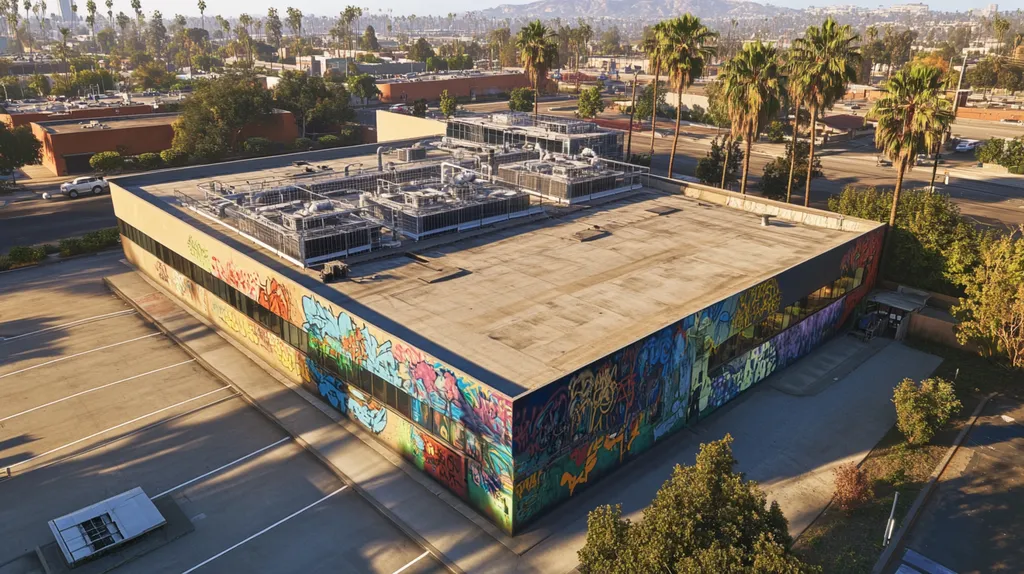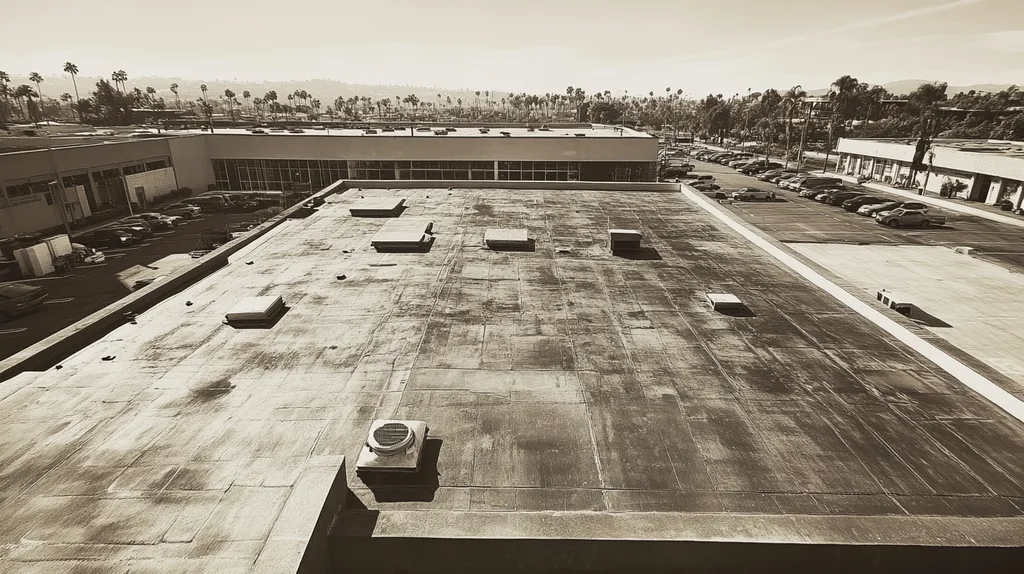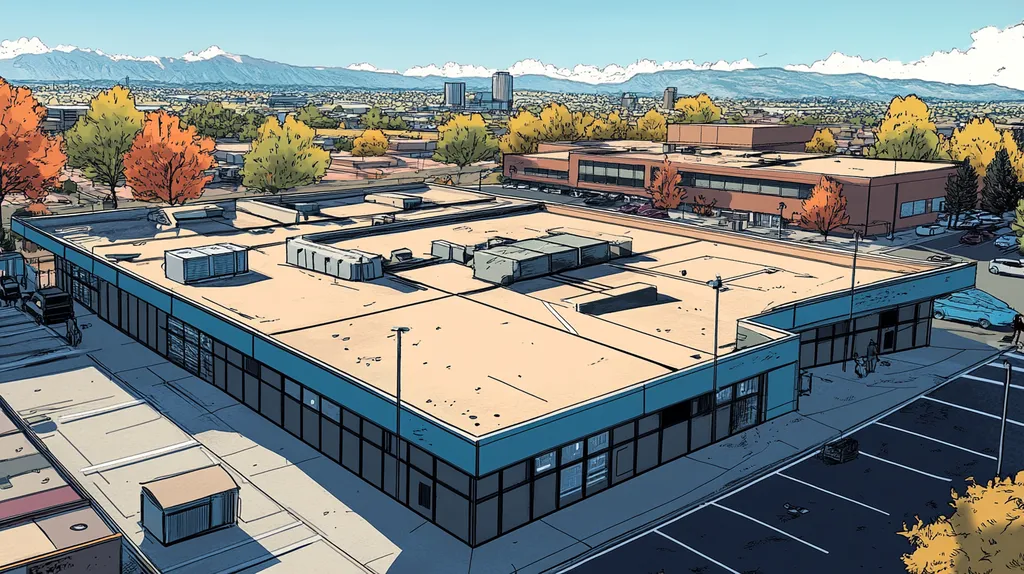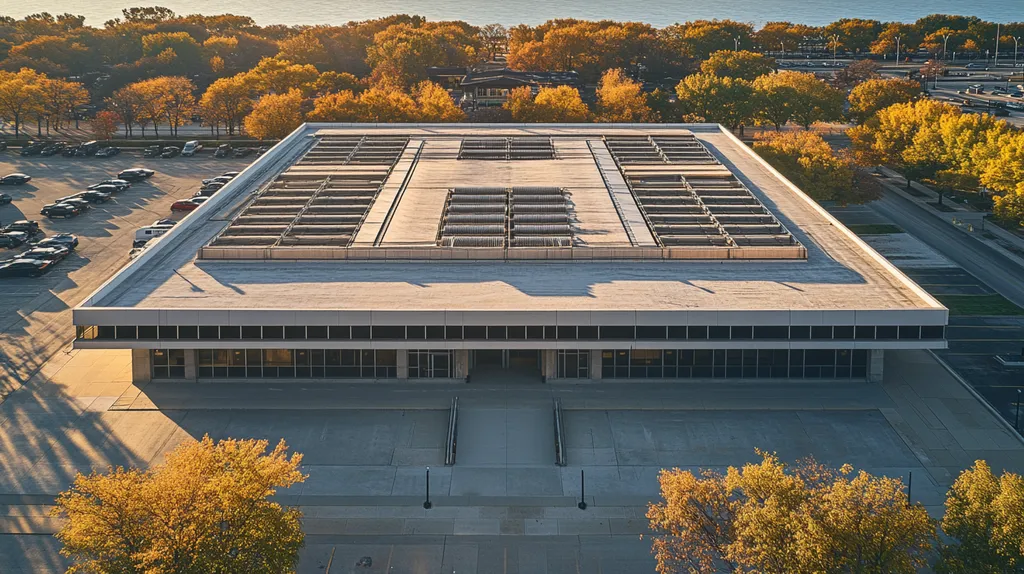Commercial roof coating failures cost property owners over $2.7 billion annually in repairs and energy losses, yet many continue to rely on outdated materials that compromise building protection.
Despite significant advances in coating technology over the past decade, approximately 70% of commercial properties still utilize traditional materials that demonstrate inferior performance and shortened lifespans.
This analysis examines why established coating choices often fail to deliver optimal results, exploring systemic issues in material selection while presenting evidence-based alternatives that better serve modern building requirements.
SECTION 1: CURRENT PRACTICES
In the realm of commercial roofing, selecting the right coating materials is critical for ensuring both optimal performance and longevity. Alarmingly, research indicates that nearly 30% of flat roofs fail within twenty years, primarily due to inferior material choices. For property owners and facility managers, making informed decisions about coatings is essential to maintain roof durability. This section will delve into widely-used coating materials, their application techniques, and the maintenance practices that significantly affect a roof’s effectiveness.
Commonly Used Coating Materials
The commercial roof coating market is primarily dominated by a few key materials. Acrylic, silicone, and polyurethane stand out as the top choices among property owners. Acrylic coatings are favored for their exceptional UV resistance and eco-friendly, water-based application process.
Silicone coatings are particularly renowned for their waterproofing capabilities, making them ideal in regions susceptible to heavy rainfall. Nonetheless, these coatings necessitate proper substrate preparation to ensure effective adhesion. Polyurethane coatings shine in durability and chemical resistance, but their higher cost and complex application methods can deter some users.
While each of these materials offers distinct advantages, relying solely on traditional options can stifle innovation in roofing technology. As advancements continue to emerge, property managers should remain vigilant about exploring newer options that may outperform established products.
Grasping the strengths and weaknesses of these coatings is vital for making educated decisions that protect building investments. Property owners are urged to actively seek alternatives that promise enhanced long-term performance.
Application Methods and Challenges
How coatings are applied can drastically influence the overall effectiveness of a roofing system. Common methods include spray, roll, and brush applications, each accompanied by unique advantages and disadvantages. Spray applications cover extensive surfaces quickly but require skilled technicians to avoid overspray and ensure even thickness.
Using a roller is straightforward and is well-suited for smaller areas, though multiple coats may be necessary for complete coverage. Brush applications are excellent for detailed work but may result in inconsistent finishes over larger areas. Each method presents challenges that can affect the quality of the final product.
Environmental conditions such as humidity and temperature further complicate the application process. Ignoring these factors can result in adhesion issues and hastened coating failures.
Given these difficulties, the importance of advanced training and improved application practices is evident. Investing in skilled labor is crucial to guarantee that coating materials deliver the performance necessary for long-term success.
Maintenance and Inspection Practices
Consistent maintenance and thorough inspections are imperative for extending the lifespan of commercial roofs. Systematic checks can pinpoint potential problems like surface wear or water infiltration before they lead to expensive repairs. It’s recommended that inspections be conducted at least twice a year, with attention to areas vulnerable to damage.
Effective maintenance practices, such as debris removal and seam repairs, directly influence the durability of coatings. Neglecting these routine tasks can diminish performance and increase the risk of costly leaks or structural damage.
Presently, many property owners underestimate the importance of preventative maintenance, resulting in inflated repair costs and reduced overall efficiency of the building. Embracing a proactive maintenance and inspection strategy can yield significant savings for property owners.
These observations reinforce the notion that complacency in maintenance can pose significant risks. For property managers, making continuous evaluation a priority is essential to uphold the protective capabilities of roofing systems.
SECTION 2: SYSTEMIC ISSUES
Addressing the systemic issues associated with current commercial roof coating materials is essential for property owners and facility managers. Alarmingly, nearly 30% of all roofing failures can be directly linked to material deficiencies. This reality poses severe consequences, including extensive property damage, operational disruptions, and costly financial losses. This section explores the limitations of established materials by examining their durability, weather resistance, and ongoing maintenance challenges.
Limited Durability and Lifespan
A significant concern with prevailing commercial roof coatings is their limited durability. Many traditional materials fall short in longevity, resulting in early failures. For instance, standard acrylic coatings may last only five to seven years under ideal conditions, leading to frequent and costly replacements.
Consistent exposure to harsh environmental factors accelerates wear and tear on these coatings. Elements such as UV rays, heavy rain, and extreme temperature shifts can compromise their structural integrity, resulting in cracks and peeling. If not swiftly addressed, these failures can escalate into more serious problems.
From an economic standpoint, premature coating failures force property owners into a cycle of increased downtime and repair expenses, as accessing and repairing roofing systems disrupts daily business operations. Relying on materials with such limited lifespans can lead to financial strain due to ongoing repair needs.
Investing in roofing systems that offer greater durability is crucial for minimizing long-term costs and enhancing overall resilience. Innovative material solutions may provide the key to significantly extending the life of roof coatings.
Inadequate Weather Resistance
Another notable shortcoming of traditional roof coating materials is their insufficient weather resistance. Many standard options are not engineered to withstand severe weather conditions, placing properties at risk during storms. This increased vulnerability can lead to moisture infiltration and subsequent damage to interior structures and valuable assets.
For example, typical roof coatings often struggle against high winds and heavy rainfall, especially in areas susceptible to extreme weather. When coatings fail to repel moisture effectively, the likelihood of mold growth and structural degradation rises.
Additionally, businesses operating across diverse climates may face a range of weather-related challenges. It is imperative to invest in coatings specifically designed for enhanced weather resistance to protect properties from localized threats. Neglecting this aspect can result in expensive repairs and significant financial losses.
By prioritizing weather-resistant materials, property owners can ensure their roofing systems provide reliable, long-lasting protection, which ultimately enhances the overall value of their investments.
High Maintenance and Repair Costs
The high maintenance and repair costs that accompany outdated commercial roof coating materials represent another systemic issue. Many traditional products necessitate frequent upkeep to stay effective, adding both financial and logistical burdens for property managers. For example, a typical commercial roof might require seasonal inspections to prevent leaks caused by aging coatings.
Property owners may end up devoting considerable budgets to maintenance, which diverts essential funds from other critical operational needs. As coatings deteriorate, the demand for repairs amplifies, becoming a recurring financial burden.
Moreover, labor costs associated with necessary repairs can quickly accumulate, particularly during urgent situations. In high-pressure environments, such repairs can lead to significant operational disruptions, negatively impacting productivity and profitability.
Evaluating alternative materials that provide lower maintenance requirements and greater reliability could significantly alleviate these ongoing costs. The focus should shift towards developing roofing systems designed for longevity and reduced intervention throughout their lifecycle.
SECTION 3: MISSED OPPORTUNITIES
Many commercial property owners and facility managers are overlooking essential advancements in roofing technology. Sticking with traditional coating materials may result in suboptimal lifespan and performance, especially when more advanced options are available. This oversight can escalate costs and diminish energy efficiency, negatively impacting businesses over time. Understanding these missed opportunities is vital for enhancing roof performance and achieving significant financial savings.
Overlooking Advanced Coating Technologies
The roofing industry is rapidly evolving, yet many property owners hesitate to embrace new materials. Innovative coatings like silicone and polyurea provide exceptional waterproofing and UV protection, significantly improving roof longevity and decreasing maintenance requirements.
By ignoring these advanced options, property owners forfeit valuable features such as self-sealing properties and greater reflectivity. Reflective coatings can lower rooftop temperatures, driving down cooling costs. Relying on conventional materials restricts the potential for resilience and efficiency in commercial roofing.
Failure to stay updated on technological advances means investing in less effective solutions. As the roofing landscape changes, so should the materials chosen to protect properties. Embracing innovative technologies is crucial for maximizing a roof’s overall performance.
Ignoring Energy Efficiency Benefits
Energy efficiency is increasingly important in modern building management; however, many roof coatings fall short in this area. Traditional materials typically lack effective sunlight reflection, which can heighten energy consumption levels. In contrast, energy-efficient coatings can significantly reduce cooling loads during warmer months.
For instance, a reflective roof coating can cut energy bills by as much as 30%, yielding a substantial return on investment. This transition is not only an environmental consideration but also a savvy financial strategy. Improved energy efficiency can enhance a building’s sustainability rating and make it more attractive to potential tenants.
Neglecting energy-efficient options raises utility costs and may lead to quicker degradation of existing roofing materials. An energy-efficient roof not only reduces expenses but also positively influences a building’s environmental footprint.
Neglecting Long-Term Cost Savings
In roofing decisions, short-term cost-saving strategies frequently overshadow longer-term financial benefits. Many property owners initially select lower-cost, traditional coatings, unaware of their potential for high maintenance and repair expenses. While advanced coatings may require a higher upfront investment, their durability can lead to significant savings over time.
For example, a standard coating may need resealing every few years, whereas newer materials could last up to a decade without major repairs. This durability translates into thousands of dollars saved over the lifespan of a roofing system. Property owners must evaluate initial costs against total lifecycle expenses to make informed decisions.
Moreover, long-lasting advanced coatings can lead to reduced waste and a smaller environmental footprint, enhancing overall cost-effectiveness. Delaying the adoption of superior materials risks locking property owners into outdated maintenance cycles that ultimately impact their bottom line.
SECTION 4: ROOT CAUSES
Commercial roof coating failures often stem from critical issues that can easily be overlooked. The financial implications of a failed coating can extend into the thousands, encompassing both repairs and lost productivity. Unfortunately, property owners and facility managers may not fully grasp these underlying causes, risking repeated costly errors. This section will examine key factors that contribute to the ineffective performance of traditional roof coating materials.
Lack of Material Compatibility
A primary factor driving failures in commercial roof coatings is the lack of material compatibility. Many coatings are applied over existing roofs without careful consideration of how they will interact. For example, using a silicone coating over an incompatible substrate may lead to delamination, which can compromise the integrity of the roofing system.
When incompatible materials are applied, they may expand and contract at differing rates, resulting in cracks and tears that often go unnoticed until the damage escalates. Ignoring material compatibility not only jeopardizes a roof’s performance but can also void the warranty on the roofing system.
Additionally, manufacturers often create coatings specifically tailored for certain substrates. Not adhering to these recommendations can result in significant performance issues. Prioritizing compatibility is essential for maximizing the life expectancy of the roofing system.
Property owners should engage in thorough research or consult specialized experts to assess material compatibility proactively. This informed approach can yield significant time and cost savings in the long run.
Inadequate Surface Preparation
Surface preparation is a critical step that significantly impacts the longevity of roof coatings, yet it is frequently neglected. Most coatings require a clean, dry, and suitably textured surface for optimal adhesion. A lack of adequate surface preparation can lead to uneven applications and compromised performance.
For instance, dirt, debris, or moisture trapped beneath the coating can prompt premature breakdown and deterioration. Without proper preparation, the adhesion strength of the coatings is likely to be compromised, resulting in peeling or bubbling.
Furthermore, inadequate surface preparation may double the expenses involved with coatings and extend project timelines. Utilizing effective preparation techniques, such as power washing and repairing existing damage, is imperative to ensure that coatings bond correctly.
Implementing training and awareness in best practices for surface preparation can dramatically enhance success rates. Facilities managers must advocate for these essential practices to safeguard their roofing investments.
Insufficient Training for Installers
The effectiveness of roof coating application is largely dependent on the skills and expertise of the installers. When installers lack proper training, they may employ poor application techniques that jeopardize the coating’s integrity. Misapplication is a common reference in failure reports, emphasizing the necessity for skilled professionals.
For example, failing to account for drying times or optimal temperature conditions can lead to coatings that do not perform effectively. Additionally, many installers may lack an understanding of the specific requirements associated with different materials, which can result in incorrect application practices.
Moreover, without ongoing training, even seasoned installers may fall behind on the latest advancements in the industry. This knowledge gap can diminish the performance of high-quality materials significantly.
Investing in comprehensive training and certification programs for roofing installers is vital to ensure they are well-equipped to handle various materials and scenarios. A skilled installer can not only apply coatings accurately but can also identify potential issues before they become major problems.
DATA DRIVEN EVIDENCE
In the commercial roofing sector, the urgency to select the right materials has never been more pronounced. With studies revealing that over 30% of commercial roofs fail within the first 15 years, property owners must harness performance data to guide their decisions. This section examines crucial performance metrics, analyzes damning case studies of coating failures, and offers a thorough cost-benefit analysis. These insights are vital for facilities managers aiming to protect investments and enhance roof performance.
Performance Data of Different Coatings
Understanding the performance metrics of various roof coating materials is essential when evaluating their long-term viability. Reflective coatings, for instance, can cut energy costs by as much as 20% annually compared to conventional materials. Research indicates that silicone coatings can last between 10 to 20 years without significant degradation, while acrylic coatings may require reapplication every five years.
Durability tests reveal that elastomeric coatings exhibit superior resistance to harsh weather, outperforming traditional systems. Variances in elasticity and tensile strength profoundly affect performance, particularly in climates subject to severe weather. Hence, recognizing these differences is vital for effective maintenance strategies and operational budgeting.
Field studies corroborate that roofs treated with high-performance coatings experience fewer leaks. These coatings expand and contract better with temperature changes, enhancing the integrity of the building over time. Consequently, choosing the right product can greatly reduce maintenance costs in the long run.
The long-term energy efficiency of reflective coatings should also be carefully weighed against their initial installation costs. The anticipated savings on energy and maintenance often outweigh the upfront investment, reinforcing the necessity for data-driven decision-making.
Case Studies on Coating Failures
Examining case studies sheds light on the pitfalls of relying on outdated roofing materials. One notable instance involved a major retail chain that opted for a traditional acrylic coating. This choice quickly deteriorated under UV exposure, resulting in leaks and costly repairs just three years post-application, compounded by excessive water pooling in critical areas.
Another case involved an industrial facility that selected a low-cost, non-reflective coating, leading to soaring energy costs. Over five years, expenditures surged by nearly 30% due to increased cooling demands, starkly illustrating the risks of prioritizing short-term savings without considering long-term repercussions.
Additionally, a manufacturing plant faced significant financial setbacks when polyester coatings failed to adhere properly due to inadequate surface preparation. The reapplication process not only incurred hefty labor costs but also disrupted production for weeks, highlighting the importance of diligent research and selection before finalizing coating choices.
Industry professionals must scrutinize such failures to avoid similar missteps. Learning from these examples provides property owners valuable insights to opt for reliable alternatives, promoting longevity and consistent performance.
Cost-Benefit Analysis of Coating Options
A comprehensive cost-benefit analysis underscores the financial rationale behind investing in superior roofing materials. Though premium coatings like silicone or polyurea demand higher initial expenditures, their extended lifespan and decreased maintenance needs present significant economic advantages. Projections indicate these high-performance coatings can last two to four times longer than standard options.
Energy savings factor prominently in this analysis, as reflective roof coatings—while sometimes pricier upfront—can substantially lower HVAC operational costs. Property owners should factor in these extended cost savings when assessing the overall return on investment.
In prior project evaluations, properties that prioritized high-quality coatings consistently reported lower annual repair and maintenance expenditures, contributing to overall budgetary efficiency. Additionally, instances of insurance claims related to roofing failures notably declined, enhancing the financial health of property management.
Ultimately, understanding the intricate relationship between initial costs and long-term benefits enables more informed financial decisions. Investing in high-quality commercial coatings not only promises cost savings but also boosts operational efficiency and elevates property values over time.
SECTION 6: ALTERNATIVE SOLUTIONS
The imperative for property owners and facility managers to explore alternative solutions for roof coatings is clearer than ever. Traditional materials frequently fall short, lacking in performance, lifespan, and environmental sustainability. With studies indicating that ineffective roofing can lead to energy losses of up to 30%, it is essential to examine modern advancements in materials. This section highlights the valuable alternatives available, focusing on silicone and polyurethane coatings, as well as reflective and elastomeric options, coupled with innovative application techniques.
Adopting Silicone and Polyurethane Coatings
Silicone and polyurethane coatings are emerging as superior alternatives to traditional roofing materials. These coatings excel in waterproofing and flexibility, crucial factors in preventing leaks. For instance, silicone coatings are exceptionally resilient against extreme weather, significantly prolonging the lifespan of roofing systems.
Polyurethane coatings stand out for their excellent puncture and impact resistance, making them ideal for high-traffic roofs where foot traffic is common. Both types of coatings also improve energy efficiency by reflecting harmful UV rays, which contributes to lower cooling expenses.
By choosing silicone or polyurethane coatings, property owners can achieve long-term cost savings. These materials not only extend the life of the roof but also reduce energy consumption, offering substantial returns on investment—especially vital for facilities aiming to keep operational costs in check.
Moreover, these coatings often contain low levels of volatile organic compounds (VOCs), enhancing their environmental friendliness. This characteristic aligns with the growing trend towards sustainable practices and allows property owners to positively impact their community.
Implementing Reflective and Elastomeric Coatings
Reflective and elastomeric coatings present another strong alternative to traditional roofing options. Reflective coatings can significantly decrease heat absorption, lowering roof temperatures by as much as 30%. This benefit is particularly advantageous in urban areas suffering from heat island effects.
Elastomeric coatings are recognized for their ability to adapt to temperature fluctuations, effectively minimizing the risk of cracking and damage over time. For facilities experiencing varying weather conditions, this adaptability can be transformative.
Utilizing reflective coatings not only preserves the structural integrity of the roof but also enhances energy efficiency. Facilities that implement such coatings frequently observe noteworthy reductions in cooling costs, offering strong financial incentives for property owners.
These advanced coatings also assist in meeting green building standards, enhancing the market appeal of properties. Investing in reflective and elastomeric solutions allows property owners to bolster their sustainability efforts and attract environmentally-conscious tenants.
Integrating New Application Techniques and Materials
Innovative application techniques and materials are reshaping the roofing industry. Spray foam roofing, for example, provides seamless applications that reduce leak points while offering exceptional insulation properties. This approach can lead to improved energy efficiency and excellent overall roof performance.
Emerging materials now feature quick-drying properties, enabling faster project completions. This aspect minimizes disruptions for businesses with demanding schedules, significantly reducing downtime.
Additionally, advancements in application technology enhance both durability and performance. Modern machinery can ensure a uniform application that boosts the roof’s long-term resilience, offering substantial qualitative improvements over traditional methods.
By embracing these cutting-edge techniques and materials, property owners can lead the industry in innovative roofing practices. This forward-thinking strategy safeguards their investments and improves the marketability of their properties in a competitive landscape.
The Bottom Line
With over $2.7 billion lost annually to roof coating failures, the commercial roofing industry stands at a critical crossroads between outdated practices and innovative solutions.
The evidence clearly demonstrates that traditional coating materials consistently underperform in durability, weather resistance, and energy efficiency.
Advanced alternatives like silicone, polyurethane, and reflective coatings offer superior protection while reducing long-term maintenance costs by up to 40%.
Property owners who continue relying on conventional materials risk not only increased operational expenses but also compromise their buildings’ structural integrity and energy performance.
The path forward requires embracing evidence-based coating solutions that maximize durability, minimize environmental impact, and deliver measurable returns on investment through reduced maintenance and energy costs.
FREQUENTLY ASKED QUESTIONS
Q. What commercial roof coatings are currently popular?
A. Popular commercial roof coatings include acrylic, silicone, and polyurethane. Each material offers unique advantages such as UV resistance, waterproofing, and durability. Evaluating these options carefully can ensure long-lasting performance and reduce future maintenance costs.
Q. How do systemic issues affect commercial roof materials?
A. Systemic issues, including limited durability and maintenance challenges, can lead to costly failures. These deficiencies necessitate frequent repairs and increase overall operational costs. Understanding these issues allows property owners to make better material choices that enhance roof performance.
Q. What are the missed opportunities in commercial roofing?
A. Missed opportunities often include overlooking advanced coating technologies and energy-efficient materials. Sticking with traditional options can lead to shorter lifespans and higher operational costs, which ultimately affect sustainability and business performance.
Q. What are common root causes of coating failures?
A. Common root causes include lack of material compatibility, inadequate surface preparation, and insufficient training for installers. These issues can severely compromise the effectiveness of roof coatings, leading to premature failures and costly repairs.
Q. How does data drive decisions in commercial roofing?
A. Data-driven insights reveal performance metrics of various coatings, highlighting their longevity and cost-benefit ratios. Analyzing case studies on coating failures also guides informed decision-making, helping property owners select the most effective materials for their roofs.
Q. What alternative solutions exist for commercial roofing materials?
A. Alternative solutions such as silicone and polyurethane coatings offer superior performance and sustainability. Reflective and elastomeric options also provide benefits like enhanced energy efficiency, making them viable alternatives to traditional materials for commercial roofs.
Q. How can I maximize the lifespan of my commercial roof?
A. To maximize your commercial roof’s lifespan, prioritize proper material selection, regular maintenance, and detailed inspections. Engaging skilled installers familiar with advanced application techniques can further enhance performance and durability, ultimately protecting your investment.











